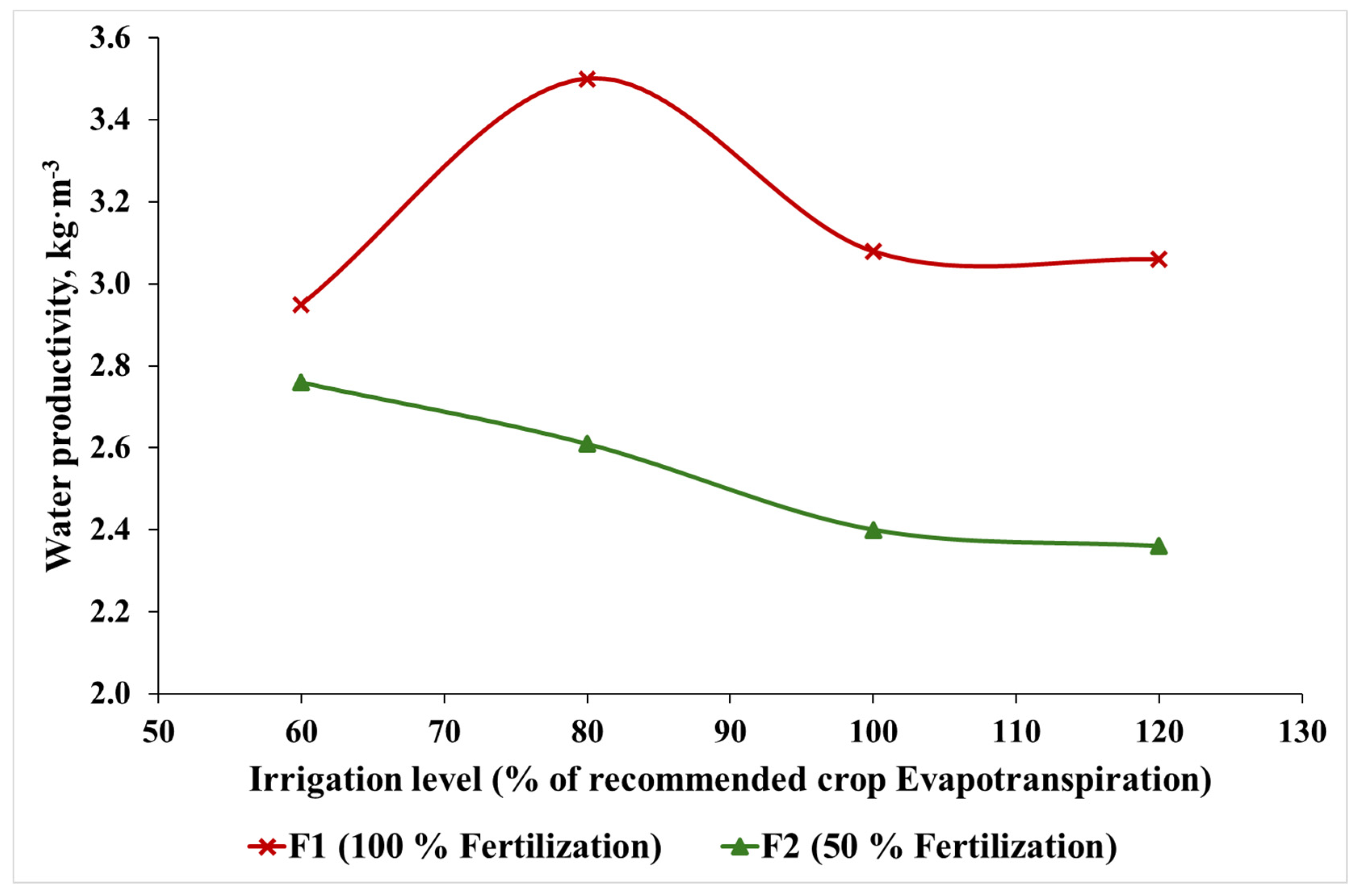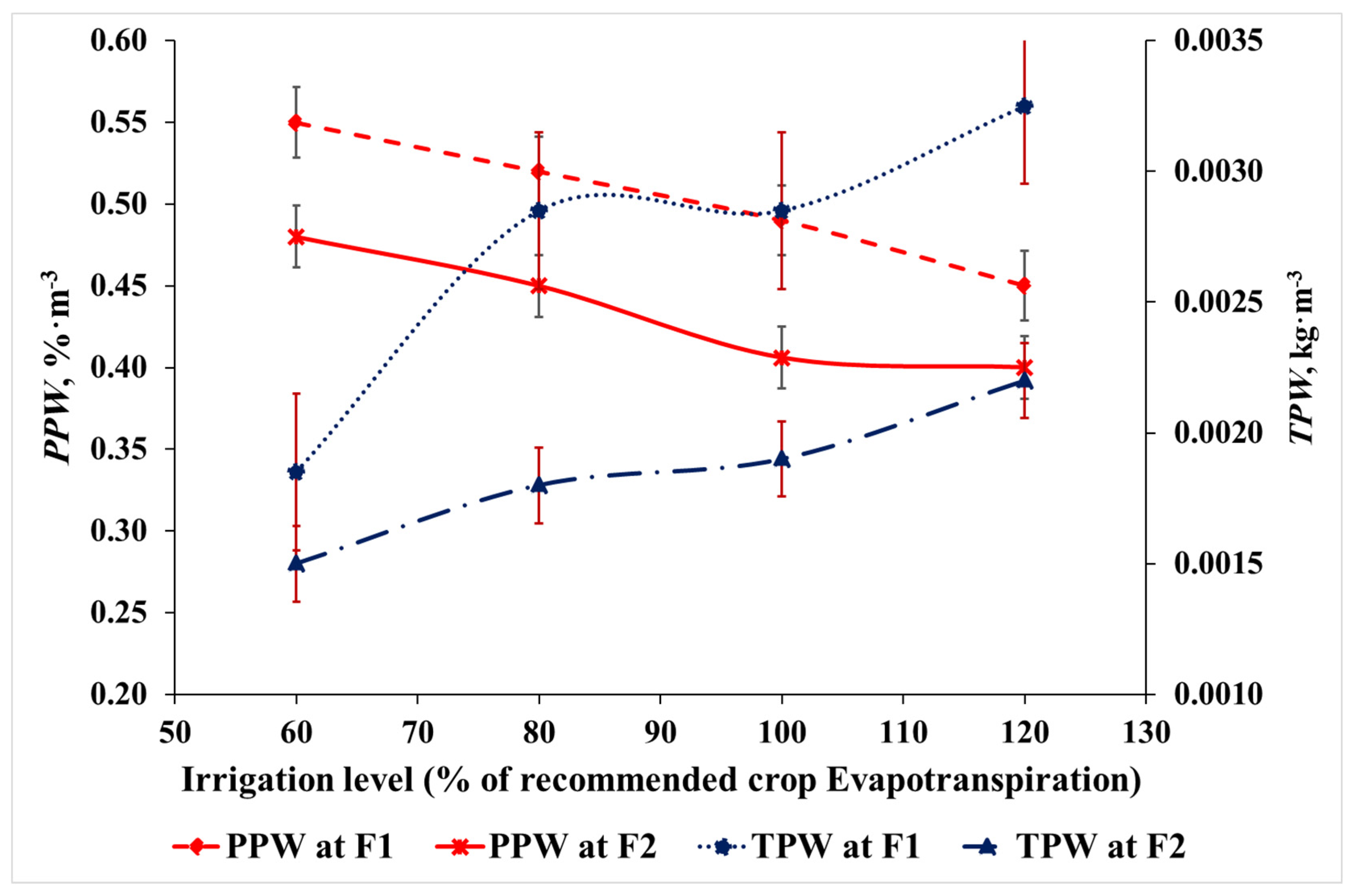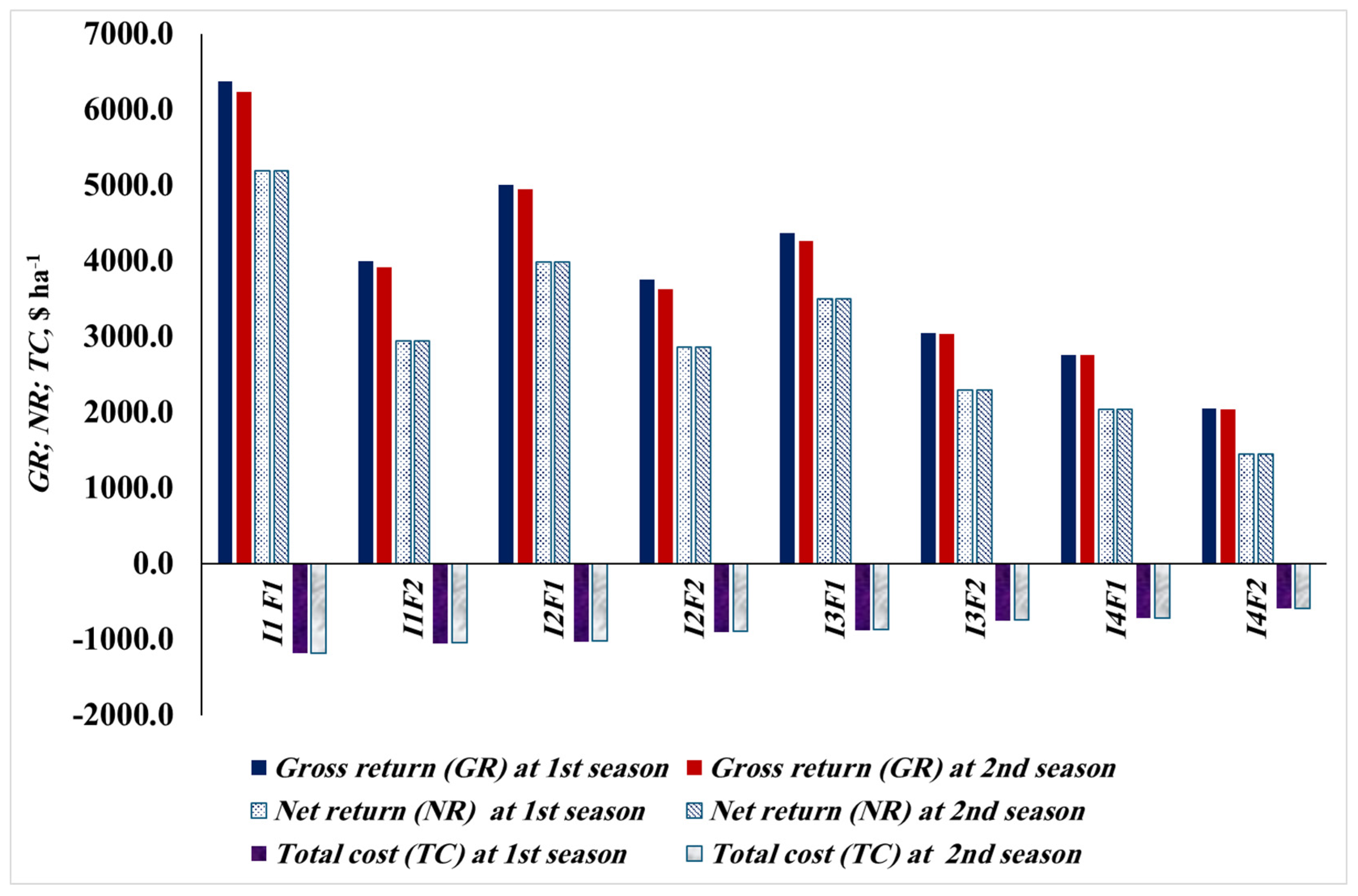Efficient Strategy for Water and Nutrient Management to Economically Enhance Mombasa Grass Productivity
Abstract
1. Introduction
2. Materials and Methods
2.1. Measurements and Calculation
2.2. Economic Evaluation
2.3. Statistical Analysis
3. Results
3.1. Irrigation and Fertilization Effects on Mombasa Grass Traits
3.2. Effect of Irrigation and Fertilization Levels on Water Productivity
3.3. Effect of Irrigation and Fertilization Levels on Protein
3.4. Economic Evaluation
4. Discussion
5. Conclusions
Author Contributions
Funding
Data Availability Statement
Acknowledgments
Conflicts of Interest
References
- Viciedo, D.O.; de Mello Prado, R.; Martínez, C.A.; Habermann, E.; de Cássia Piccolo, M. Short-term warming and water stress affect Panicum maximum Jacq. stoichiometric homeostasis and biomass production. Sci. Total Environ. 2019, 681, 267–274. [Google Scholar] [CrossRef] [PubMed]
- Hidosa, D.; Adicha, A.; Sultan, M. Production and commercialization status of improved panicum grass cultivation in the lowland livestock production system of South Omo South-Western Ethiopia. Res. World Agric. Econ. 2022, 3, 12–24. [Google Scholar] [CrossRef]
- Pereira, V.V.; Fonseca, D.M.D.; Martuscello, J.A.; Cecon, P.R.; Santos, M.V.; Braz, T.G.D.S. Biomass accumulation in mombasa guinea grass plants under different levels of nitrogen supply and plant densities. Rev. Bras. Zootec. 2012, 41, 1118–1126. [Google Scholar] [CrossRef]
- Dias, M.B.D.C.; Costa, K.A.D.P.; Severiano, E.D.C.; Bilego, U.O.; Vilela, L.; de Souza, W.F.; de Oliveira, I.P.; da Silva, A.C.G. Cattle performance with Brachiaria and Panicum maximum forages in an integrated crop-livestock system. Afr. J. Range Forage Sci. 2022, 39, 230–243. [Google Scholar] [CrossRef]
- Albiac, J.; Calvo, E.; Kahil, T.; Esteban, E. The challenge of irrigation water pricing in the Water Framework Directive. Water Altern. 2020, 13, 674–690. [Google Scholar]
- Habermann, E.; Dias de Oliveira, E.A.; Contin, D.R.; Delvecchio, G.; Viciedo, D.O.; de Moraes, M.A.; de Mello Prado, R.; de Pinho Costa, K.A.; Braga, M.R.; Martinez, C.A. Warming and water deficit impact leaf photosynthesis and decrease forage quality and digestibility of a C4 tropical grass. Physiol. Plant. 2019, 165, 383–402. [Google Scholar] [CrossRef]
- Alsunaydi, S.; Alharbi, A.B.; Al-Soqeer, A.A.; Motawei, M.I. Nutritional Composition and Productivity of Panicum maximum cv. “Mombasa” Under Different Levels of Nitrogen Fertilization and Water Deficit. Life 2024, 14, 1614. [Google Scholar] [CrossRef]
- Hunter, M.C.; Kemanian, A.R.; Mortensen, D.A. Cover crop effects on maize drought stress and yield. Agric. Ecosyst. Environ. 2021, 311, 107294. [Google Scholar] [CrossRef]
- Gelley, C.H.; Ashworth, A.J.; Keyser, P.D.; Nave, R.L.; Rhinehart, J.D. Water-use efficiency of forage crops in the southeastern United States. Agronomy 2020, 10, 1377. [Google Scholar] [CrossRef]
- Jongen, M.; Pereira, J.S.; Aires, L.M.I.; Pio, C.A. The effects of drought and timing of precipitation on the inter-annual variation in ecosystem-atmosphere exchange in a Mediterranean grassland. Agric. For. Meteorol. 2011, 151, 595–606. [Google Scholar] [CrossRef]
- Anyia, A.O.; Herzog, H. Water-use efficiency, leaf area and leaf gas exchange of cowpeas under mid-season drought. Eur. J. Agron. 2004, 20, 327–339. [Google Scholar] [CrossRef]
- Ghannoum, O.; Von Caemmerer, S.; Conroy, J.P. The effect of drought on plant water use efficiency of nine NAD–ME and nine NADP–ME Australian C4 grasses. Funct. Plant Biol. 2002, 29, 1337–1348. [Google Scholar] [CrossRef]
- Hussain, M.Z.; Grünwald, T.; Tenhunen, J.D.; Li, Y.L.; Mirzae, H.; Bernhofer, C.; Otieno, D.; Dinh, N.Q.; Schmidt, M.; Wartinger, M.; et al. Summer drought influence on CO2 and water fluxes of extensively managed grassland in Germany. Agric. Ecosyst. Environ. 2011, 141, 67–76. [Google Scholar] [CrossRef]
- Carter, M.R.; Gregorich, E.G. Soil Sampling and Methods of Analysis; CRC Press: Boca Raton, FL, USA, 2007. [Google Scholar]
- Allen, R.G.; Pereira, L.S.; Raes, D.; Smith, M. Crop evapotranspiration-Guidelines for computing crop water requirements-FAO Irrigation and drainage paper 56. Fao Rome 1998, 300, D05109. [Google Scholar]
- Council, A.W. Guidelines for Brackish Water Use for Agricultural Production in the Near East and North Africa Region; Food and Agriculture Organization of the United Nations: Rome, Italy, 2023. [Google Scholar]
- Alotaibi, B.A.; Baig, M.B.; Najim, M.M.; Shah, A.A.; Alamri, Y.A. Water scarcity management to ensure food scarcity through sustainable water resources management in Saudi Arabia. Sustainability 2023, 15, 10648. [Google Scholar] [CrossRef]
- Waseem, M.; Athar, H.R.; Ashraf, M.; Bhatti, A.S. Effect of water stress on growth and photosynthetic parameters of different wheat cultivars. Pak. J. Bot. 2006, 38, 1667–1674. [Google Scholar]
- Alsiteel, M.J.; Alshareef, I.M. Effect of Drought on the Growth of Two Panicum maximum jacq. Cultivars in Southern Libya. Libyan J. Agric. 2022, 27. [Google Scholar]
- Zuffo, A.M.; Steiner, F.; Aguilera, J.G.; Ratke, R.F.; Barrozo, L.M.; Mezzomo, R.; Ancca, S.M. Selected indices to identify water-stress-tolerant tropical forage grasses. Plants 2022, 11, 2444. [Google Scholar] [CrossRef] [PubMed]
- Silva, T.G.F.; Zolnier, S.; Borges, I. Water use efficiency of forage crops under different irrigation regimes and nitrogen levels. Crop Sci. 2020, 60, 2342–2355. [Google Scholar]
- Fonseca, D.M.; Martusello, J.A. Plantas Forrageiras, 2nd ed.; Editora UFV: Viçosa, Brazil, 2010; 591p. [Google Scholar]
- Ali, M.; Khan, M.A.; Ashraf, M.Y. Influence of nitrogen application on growth, yield, and water use efficiency in forage grasses under water stress. Agric. Water Manag. 2017, 191, 89–98. [Google Scholar]
- Zhang, Y.; Wang, J.; Gong, S.; Xu, D.; Sui, J. Nitrogen fertigation effect on photosynthesis, grain yield and water use efficiency of winter wheat. Agric. Water Manag. 2017, 179, 277–287. [Google Scholar] [CrossRef]
- Carvalho, I.R.; Nunes, B.T.; Rodrigues, L.B. Effect of water and nutrient availability on the productivity of tropical forage grasses. J. Grassl. Sci. 2018, 64, 204–212. [Google Scholar]
- da Silva Pause, A.G.; de Souza França, A.F.; Okada, E.S.M.; Gandra, J.R.; Dupas, E.; de Oliveira, E.R.; Ferreira, J.L.; Marques, O.F.C. Nutritional value of Mombasa grass submitted to different grazing heights and nitrogen fertilization. Braz. J. Anim. Environ. Res. 2021, 4, 860–874. [Google Scholar] [CrossRef]
- Moscoso, C.J.; Morgan, S.A.; Rivero, M.J. The effect of drying methods on water-soluble carbohydrates and crude protein concentrations and their ratio in two perennial ryegrass cultivars. Agronomy 2019, 9, 383. [Google Scholar] [CrossRef]
- Gunes, A.; Cicek, N.; Inal, A.; Alpslan, M.; Eraslan, F.; Gueri, E.; Guzelordu, T. Genotypic response of chickpea (Cicer arietinum L.) cultivars to drought stress implemented at pre-and post-anthesis stages and its relations with nutrient uptake and efficiency. Plant Soil Environ. 2006, 52, 368–376. [Google Scholar] [CrossRef]
- Garg, B.K. Nutrient uptake and management under drought: Nutrient-moisture interaction. Curr. Agric. 2003, 27, 1–8. [Google Scholar]



| Depth, cm | Distribution of the Soil Particle Size, % | Texture Class | FC *, cm3·cm−3 | PWP **, cm3·cm−3 | ||
|---|---|---|---|---|---|---|
| Sand | Silt | Clay | ||||
| 0–25 | 81.1 | 16.4 | 2.5 | Loamy Sand | 0.112 | 0.056 |
| Treatment | Season I | Season II | |||||||
|---|---|---|---|---|---|---|---|---|---|
| FW *, ton·ha−1 | DW *, ton·ha−1 | Height, cm | NO. Tillers | FW, ton·ha−1 | DW, ton·ha−1 | Height, cm | NO. Tillers | ||
| Irrigation | I1 | 81.5a ** | 18.7a | 145.4a | 23.9a | 80.9a | 18.3a | 143.9a | 24.1a |
| I2 | 74.5b | 16.8b | 136.1b | 22.9ab | 75.2b | 16.9b | 137.1b | 23.1ab | |
| I3 | 71.5b | 15.7b | 132.2b | 22.5b | 72.5b | 15.6b | 132.2b | 22.5b | |
| I4 | 63.6c | 14.9b | 122.3c | 20.7c | 63.8c | 14.8b | 122.5c | 21.3c | |
| Fertilization | F1 | 69.4a | 16.3a | 127.1a | 21.3a | 68.9a | 15.9a | 127.1a | 21.1a |
| F2 | 56.3b | 12.8b | 119.1b | 19.2a | 54.7b | 12.3b | 119.1b | 19.5a | |
| Treatment | FW, ton·ha−1 | DW, ton·ha−1 | Height, cm | NO. Tillers | |
|---|---|---|---|---|---|
| Irrigation (I) | Fertilization (F) | ||||
| I1 | F1 | 92.2a * | 21.3a | 153.1a | 25.5a |
| F2 | 70.9c | 16.0c | 137.7b | 22.3b | |
| I2 | F1 | 78.1b | 17.6b | 134.5b | 23.4a |
| F2 | 64.9d | 15.0d | 129.9b | 21.6b | |
| I3 | F1 | 62.3d | 16.1c | 114.8c | 19.8c |
| F2 | 49.3e | 14.5e | 109.3d | 18.4c | |
| I4 | F1 | 45.1f | 15.3f | 105.9d | 16.5d |
| F2 | 40.1g | 13.6f | 99.4e | 14.5e | |
Disclaimer/Publisher’s Note: The statements, opinions and data contained in all publications are solely those of the individual author(s) and contributor(s) and not of MDPI and/or the editor(s). MDPI and/or the editor(s) disclaim responsibility for any injury to people or property resulting from any ideas, methods, instructions or products referred to in the content. |
© 2025 by the authors. Licensee MDPI, Basel, Switzerland. This article is an open access article distributed under the terms and conditions of the Creative Commons Attribution (CC BY) license (https://creativecommons.org/licenses/by/4.0/).
Share and Cite
Alharbi, A.; Alsunaydi, S.; Motawei, M.I.; Alzoheiry, A.; Ghonimy, M. Efficient Strategy for Water and Nutrient Management to Economically Enhance Mombasa Grass Productivity. Agronomy 2025, 15, 1274. https://doi.org/10.3390/agronomy15061274
Alharbi A, Alsunaydi S, Motawei MI, Alzoheiry A, Ghonimy M. Efficient Strategy for Water and Nutrient Management to Economically Enhance Mombasa Grass Productivity. Agronomy. 2025; 15(6):1274. https://doi.org/10.3390/agronomy15061274
Chicago/Turabian StyleAlharbi, Abdulaziz, Saleh Alsunaydi, Mohamed I. Motawei, Ahmed Alzoheiry, and Mohamed Ghonimy. 2025. "Efficient Strategy for Water and Nutrient Management to Economically Enhance Mombasa Grass Productivity" Agronomy 15, no. 6: 1274. https://doi.org/10.3390/agronomy15061274
APA StyleAlharbi, A., Alsunaydi, S., Motawei, M. I., Alzoheiry, A., & Ghonimy, M. (2025). Efficient Strategy for Water and Nutrient Management to Economically Enhance Mombasa Grass Productivity. Agronomy, 15(6), 1274. https://doi.org/10.3390/agronomy15061274










